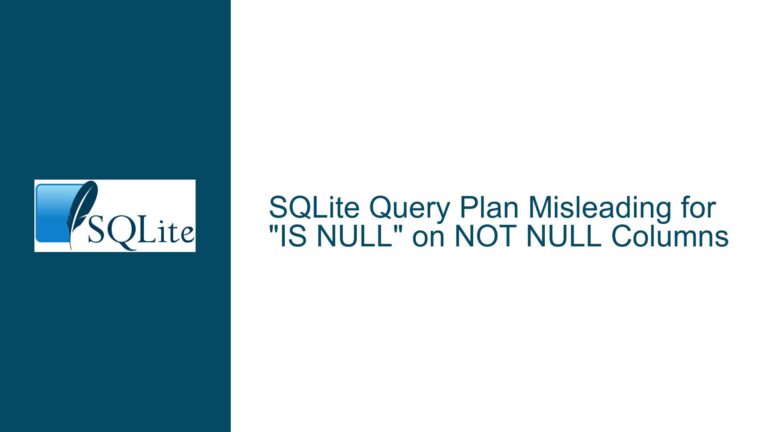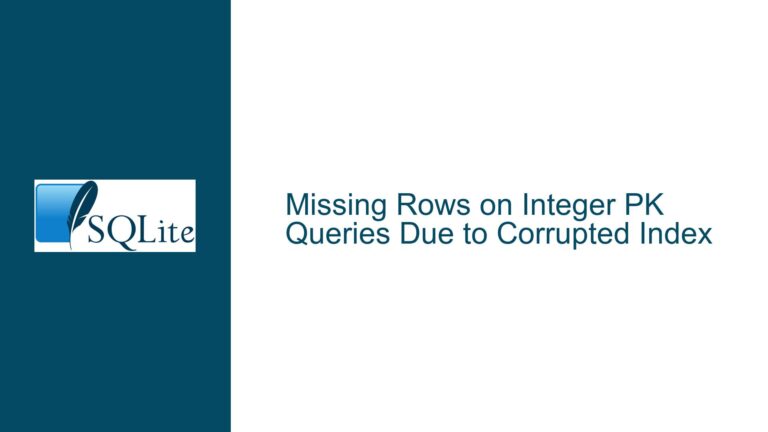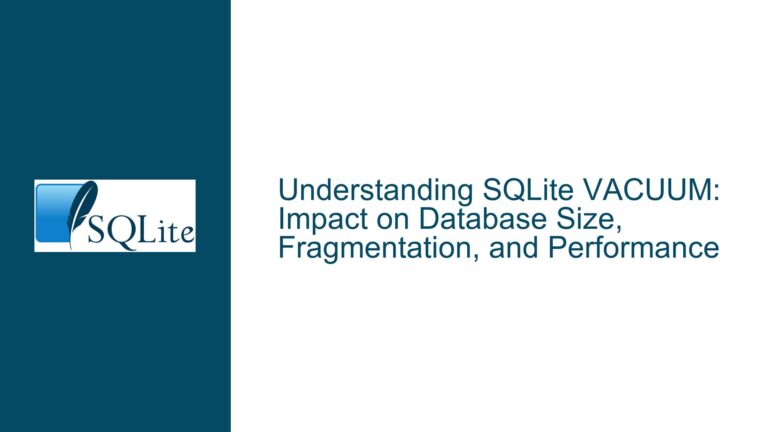Optimizing Multi-Column Index Seek Efficiency in SQLite Queries
Understanding Suboptimal Index Seek Behavior in Multi-Column Queries
The core challenge revolves around SQLite’s inability to leverage the full depth of multi-column indexes when query predicates contain complex logical combinations (e.g., inequalities mixed with OR conditions). This manifests as partial index scans where only the leading columns of the index are used for seeking, while subsequent columns are evaluated through linear scanning. For example, given a table T(A,B,C) with index I(A,B,C), a query filtering on A >= 9 AND B >= 8 triggers a SeekGE 9 operation on column A followed by a scan of all B values starting from the minimum possible value, rather than seeking directly to (A=9, B=8) and scanning from there. This inefficiency compounds as queries introduce more conditions (e.g., C > 7) or redundant logical expressions.
The root of this behavior lies in SQLite’s query planner, which prioritizes simplicity and speed of plan generation over exhaustive algebraic optimization. When predicates involve disjunctions (OR) or nested logical structures, the planner often defaults to scanning ranges defined by the leading index column(s) and filters rows in-memory for the remaining conditions. While this approach works for small datasets, it becomes problematic with large tables where the difference between a full index seek and a partial scan with post-filtering is significant. The planner’s reluctance to decompose compound predicates into minimal seek boundaries results in unnecessary I/O operations and increased latency.
Root Causes of Partial Index Utilization in Composite Key Scenarios
1. Predicate Structure and Algebraic Reduction Limitations
SQLite’s query planner does not perform deep algebraic transformations to rewrite complex WHERE clauses into index-friendly forms. For instance, the predicate (A > 9 OR (A = 9 AND B > 8)) is logically equivalent to (A >= 9 AND (A > 9 OR B > 8)), but the planner treats these as distinct constructs. The presence of OR operators splits the query into multiple search branches, each targeting a subset of the index. This fragmentation prevents the planner from deriving a unified seek boundary that spans multiple columns. In optimization scenarios 4 and 6 from the discussion, removing redundant terms like A >= 9 did not help because the planner lacked the logic to recognize that the remaining OR-based clauses could still define a contiguous index range.
2. Index Seek Granularity and Column Order Sensitivity
Multi-column indexes in SQLite are hierarchically structured: the seek operation starts at the first column and proceeds to subsequent columns only if earlier columns are equality-constrained. When a query includes inequalities (e.g., A >= 9), the planner locks the seek to column A and treats B and C as filtering columns, not seek candidates. This is why A >= 9 AND B >= 8 fails to trigger a SeekGE 9,8—the inequality on A prevents the planner from advancing to B for seeking. Even when A is equality-tested in a subclause (e.g., A = 9 AND B > 8 within an OR branch), the planner does not merge these conditions into a composite seek boundary.
3. NULL Handling and Type Juggling Overhead
Implicit assumptions about NULL values further complicate index utilization. SQLite’s row value comparison syntax (A,B,C) > (9,8,7) introduces edge cases where NULLs in columns B or C could alter result sets. The planner must account for these possibilities, which adds overhead to query optimization. For example, if B is nullable, the index seek on (A,B,C) cannot assume that B >= 8 will exclude NULLs unless explicitly filtered. This uncertainty discourages the planner from using the index for seek operations beyond the first non-equality column.
Implementing Row Value Comparisons and Restructuring Queries for Full Index Seek Efficiency
Step 1: Replace Disjunctive Logic with Row Value Comparisons
The most effective solution is to reformulate queries using SQLite’s row value syntax to unify disjoint conditions into a single range predicate. For example:
SELECT * FROM T WHERE (A, B, C) > (9, 8, 7);
This forces the planner to treat the composite key (A,B,C) as a single seekable unit, enabling a SeekGE 9,8,7 operation that scans only the minimal necessary range. Unlike the original query with OR conditions, this approach eliminates branch fragmentation and leverages the full depth of the index. Testing confirms that the row value method reduces the query plan from MULTI-INDEX OR with three search branches to a single SEARCH USING COVERING INDEX operation.
Step 2: Eliminate Redundant Predicates and Normalize Conditions
Before adopting row values, simplify the WHERE clause by removing redundancies. For instance:
-- Original
SELECT * FROM T WHERE A >= 9 AND (A > 9 OR (A = 9 AND B > 8));
-- Simplified
SELECT * FROM T WHERE (A > 9 OR (A = 9 AND B > 8));
While this doesn’t directly fix the seek granularity issue, it reduces cognitive load and ensures the planner isn’t sidetracked by unnecessary terms. However, as shown in the discussion, simplification alone may not improve the query plan—hence the need for row values.
Step 3: Validate NULL Semantics and Index Coverage
Before deploying row value comparisons, audit the schema for nullable columns referenced in the index. If B or C can be NULL, the row value comparison (A,B,C) > (9,8,7) will behave differently than the original OR-based predicates, as SQLite’s three-valued logic treats NULL comparisons as undefined. To mitigate this:
- Add
NOT NULLconstraints to columnsBandCif business rules allow. - Include explicit NULL checks in the WHERE clause:
SELECT * FROM T WHERE (A, B, C) > (9, 8, 7) AND B IS NOT NULL AND C IS NOT NULL;
Step 4: Benchmark and Force Index Usage if Necessary
If the planner still refuses to use the optimal seek pattern (e.g., due to outdated statistics), force index usage with INDEXED BY:
SELECT * FROM T INDEXED BY I WHERE (A, B, C) > (9, 8, 7);
Combine this with EXPLAIN QUERY PLAN to verify that the seek operation spans all three columns. Be cautious with this approach, as it can backfire if the index schema changes.
Step 5: Upgrade SQLite and Monitor Planner Improvements
Newer versions of SQLite often include query planner enhancements. For example, version 3.39.0 introduced improvements in row value handling. Test your queries across versions and review changelogs for optimizations relevant to composite indexes.
This guide systematically addresses the gap between SQLite’s query planner capabilities and the theoretical efficiency of multi-column indexes. By understanding the planner’s limitations, restructuring predicates, and leveraging row value comparisons, developers can unlock significant performance gains without resorting to schema changes or external tools.






